Report: Analysis of Consumer Behavior and Economic Factors
VerifiedAdded on 2021/01/02
|8
|1979
|489
Report
AI Summary
This report provides an in-depth analysis of consumer behavior, starting with a discussion of key economic terms like indifference curves, marginal rate of substitution, budget constraints, and diminishing marginal utility. It explores the concepts of income and substitution effects, explaining how changes in income and market conditions influence consumer choices. The report then delves into behavioral economics, examining the reasons behind irrational consumer behavior, including the influence of social norms, habits, and cognitive biases. The conclusion emphasizes the importance of understanding consumer behavior for businesses, highlighting the role of various factors in shaping consumer demand and preferences. The report uses academic sources to support its findings.
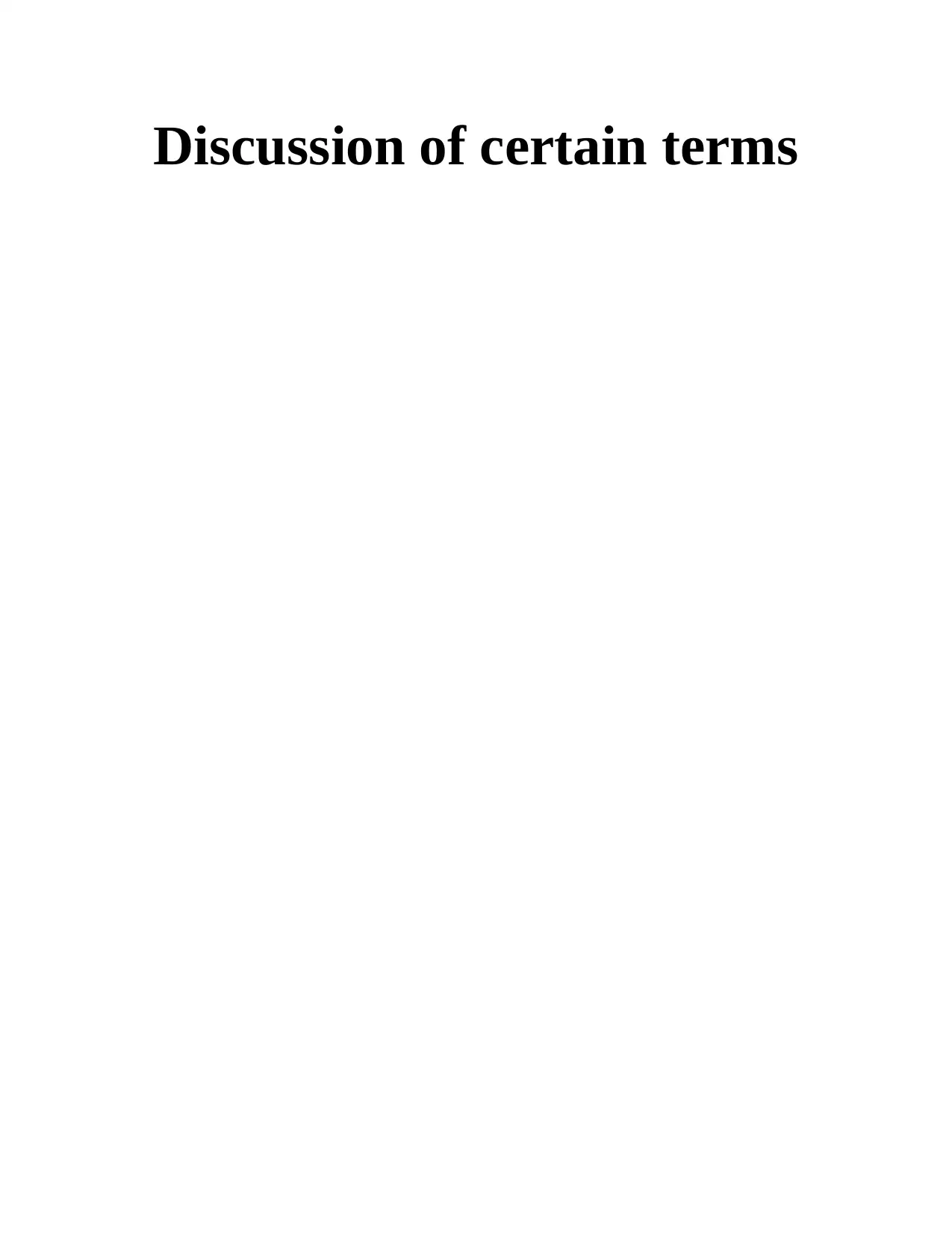
Discussion of certain terms
Paraphrase This Document
Need a fresh take? Get an instant paraphrase of this document with our AI Paraphraser
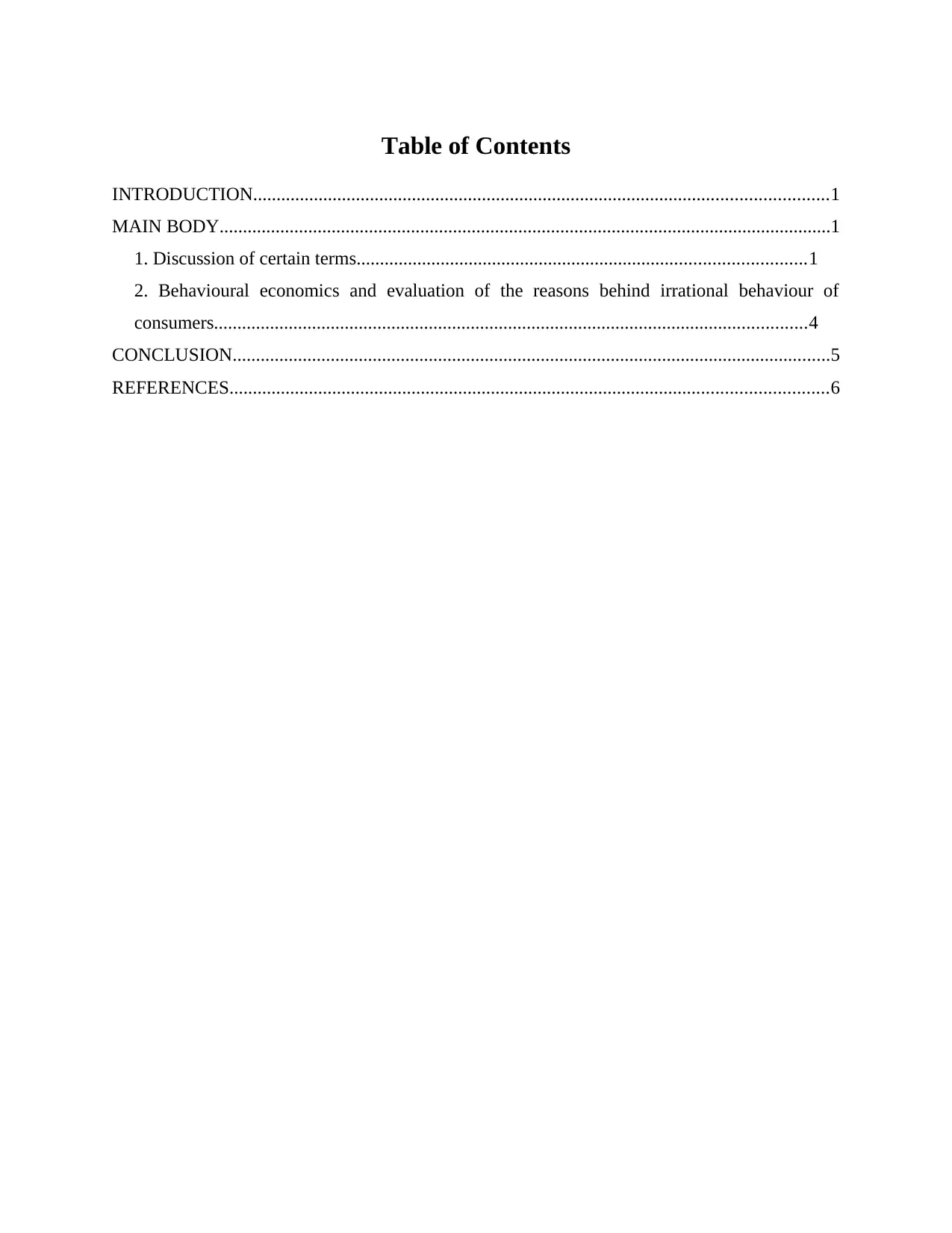
Table of Contents
INTRODUCTION...........................................................................................................................1
MAIN BODY...................................................................................................................................1
1. Discussion of certain terms................................................................................................1
2. Behavioural economics and evaluation of the reasons behind irrational behaviour of
consumers...............................................................................................................................4
CONCLUSION................................................................................................................................5
REFERENCES................................................................................................................................6
INTRODUCTION...........................................................................................................................1
MAIN BODY...................................................................................................................................1
1. Discussion of certain terms................................................................................................1
2. Behavioural economics and evaluation of the reasons behind irrational behaviour of
consumers...............................................................................................................................4
CONCLUSION................................................................................................................................5
REFERENCES................................................................................................................................6
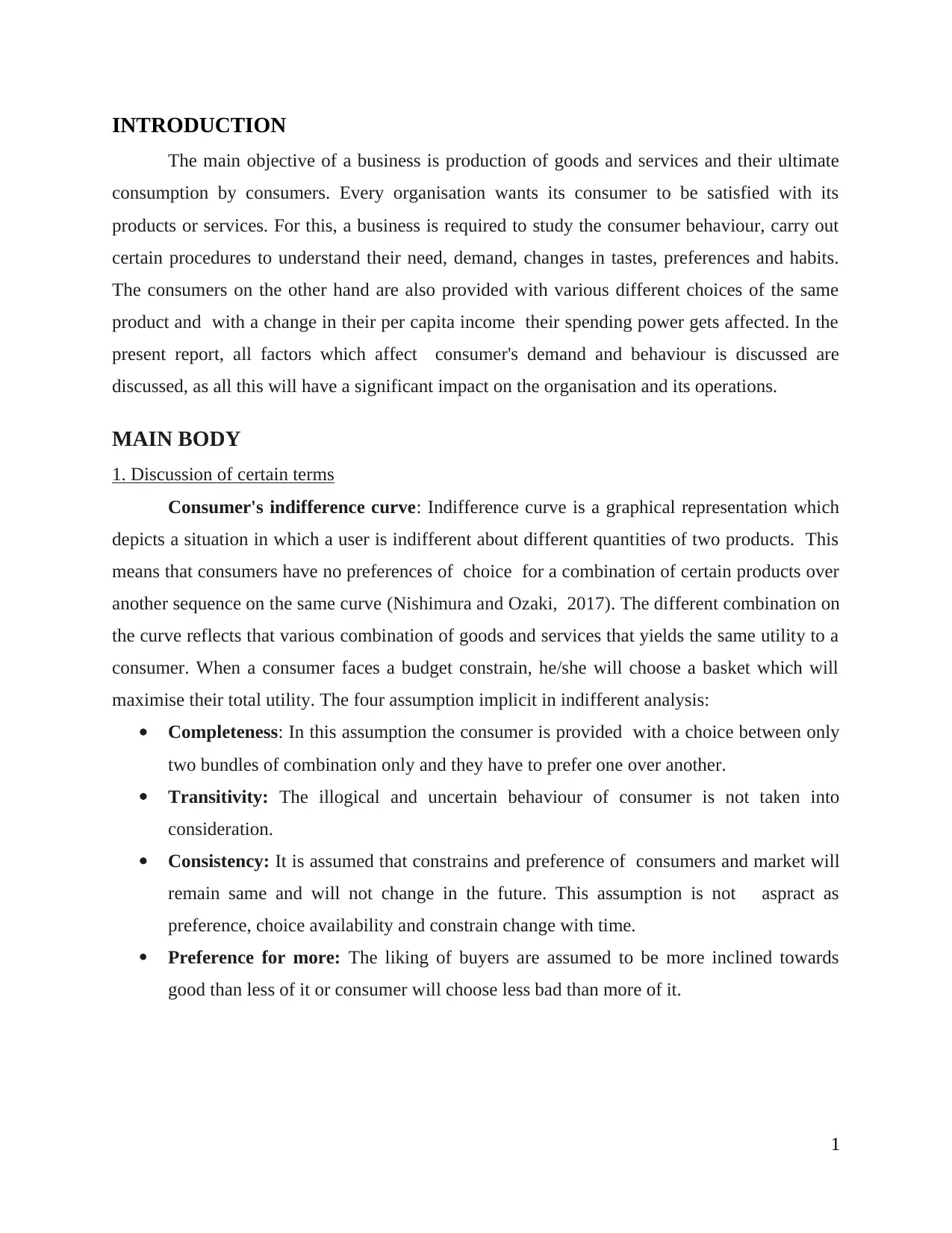
INTRODUCTION
The main objective of a business is production of goods and services and their ultimate
consumption by consumers. Every organisation wants its consumer to be satisfied with its
products or services. For this, a business is required to study the consumer behaviour, carry out
certain procedures to understand their need, demand, changes in tastes, preferences and habits.
The consumers on the other hand are also provided with various different choices of the same
product and with a change in their per capita income their spending power gets affected. In the
present report, all factors which affect consumer's demand and behaviour is discussed are
discussed, as all this will have a significant impact on the organisation and its operations.
MAIN BODY
1. Discussion of certain terms
Consumer's indifference curve: Indifference curve is a graphical representation which
depicts a situation in which a user is indifferent about different quantities of two products. This
means that consumers have no preferences of choice for a combination of certain products over
another sequence on the same curve (Nishimura and Ozaki, 2017). The different combination on
the curve reflects that various combination of goods and services that yields the same utility to a
consumer. When a consumer faces a budget constrain, he/she will choose a basket which will
maximise their total utility. The four assumption implicit in indifferent analysis:
Completeness: In this assumption the consumer is provided with a choice between only
two bundles of combination only and they have to prefer one over another.
Transitivity: The illogical and uncertain behaviour of consumer is not taken into
consideration.
Consistency: It is assumed that constrains and preference of consumers and market will
remain same and will not change in the future. This assumption is not aspract as
preference, choice availability and constrain change with time.
Preference for more: The liking of buyers are assumed to be more inclined towards
good than less of it or consumer will choose less bad than more of it.
1
The main objective of a business is production of goods and services and their ultimate
consumption by consumers. Every organisation wants its consumer to be satisfied with its
products or services. For this, a business is required to study the consumer behaviour, carry out
certain procedures to understand their need, demand, changes in tastes, preferences and habits.
The consumers on the other hand are also provided with various different choices of the same
product and with a change in their per capita income their spending power gets affected. In the
present report, all factors which affect consumer's demand and behaviour is discussed are
discussed, as all this will have a significant impact on the organisation and its operations.
MAIN BODY
1. Discussion of certain terms
Consumer's indifference curve: Indifference curve is a graphical representation which
depicts a situation in which a user is indifferent about different quantities of two products. This
means that consumers have no preferences of choice for a combination of certain products over
another sequence on the same curve (Nishimura and Ozaki, 2017). The different combination on
the curve reflects that various combination of goods and services that yields the same utility to a
consumer. When a consumer faces a budget constrain, he/she will choose a basket which will
maximise their total utility. The four assumption implicit in indifferent analysis:
Completeness: In this assumption the consumer is provided with a choice between only
two bundles of combination only and they have to prefer one over another.
Transitivity: The illogical and uncertain behaviour of consumer is not taken into
consideration.
Consistency: It is assumed that constrains and preference of consumers and market will
remain same and will not change in the future. This assumption is not aspract as
preference, choice availability and constrain change with time.
Preference for more: The liking of buyers are assumed to be more inclined towards
good than less of it or consumer will choose less bad than more of it.
1
⊘ This is a preview!⊘
Do you want full access?
Subscribe today to unlock all pages.

Trusted by 1+ million students worldwide
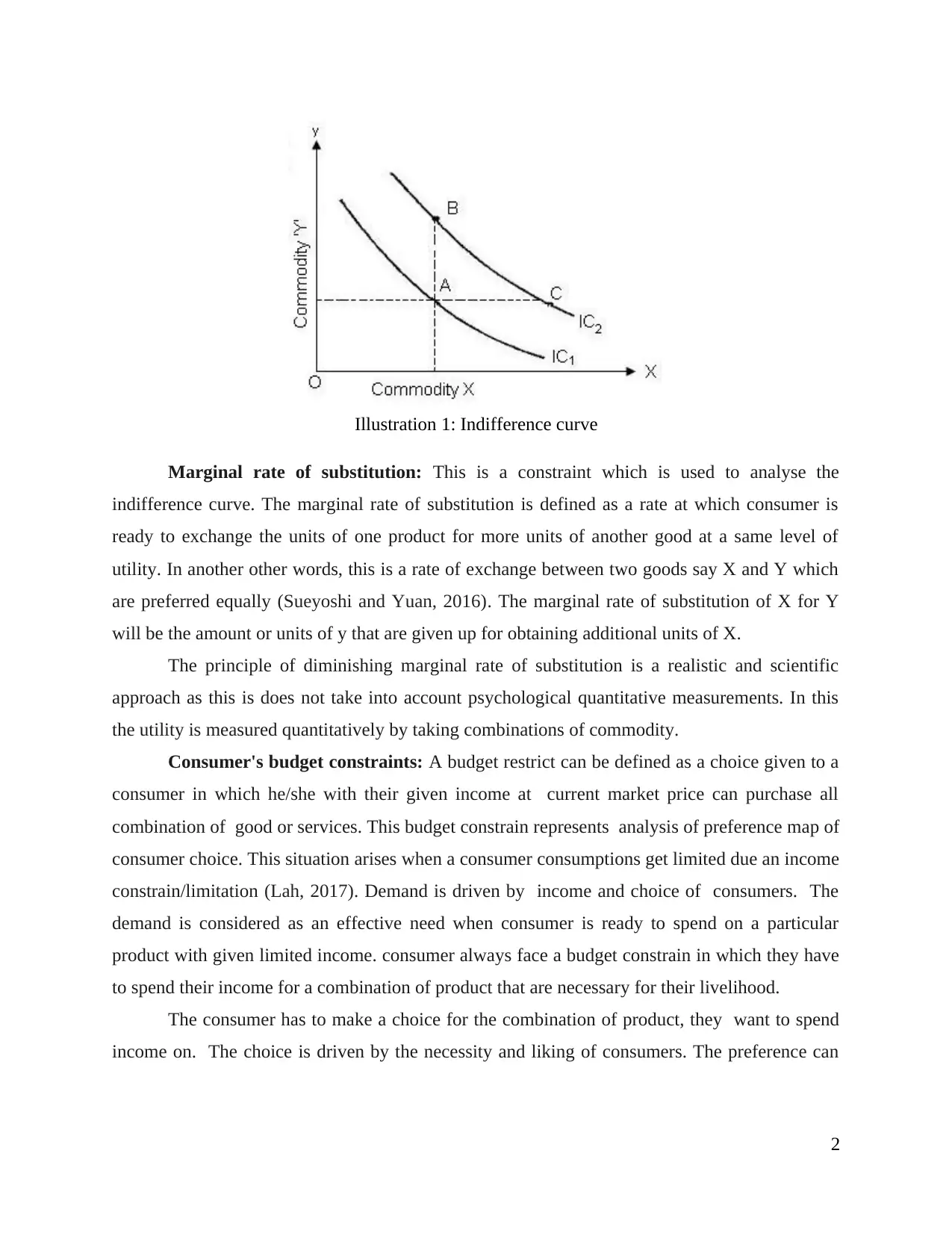
Illustration 1: Indifference curve
Marginal rate of substitution: This is a constraint which is used to analyse the
indifference curve. The marginal rate of substitution is defined as a rate at which consumer is
ready to exchange the units of one product for more units of another good at a same level of
utility. In another other words, this is a rate of exchange between two goods say X and Y which
are preferred equally (Sueyoshi and Yuan, 2016). The marginal rate of substitution of X for Y
will be the amount or units of y that are given up for obtaining additional units of X.
The principle of diminishing marginal rate of substitution is a realistic and scientific
approach as this is does not take into account psychological quantitative measurements. In this
the utility is measured quantitatively by taking combinations of commodity.
Consumer's budget constraints: A budget restrict can be defined as a choice given to a
consumer in which he/she with their given income at current market price can purchase all
combination of good or services. This budget constrain represents analysis of preference map of
consumer choice. This situation arises when a consumer consumptions get limited due an income
constrain/limitation (Lah, 2017). Demand is driven by income and choice of consumers. The
demand is considered as an effective need when consumer is ready to spend on a particular
product with given limited income. consumer always face a budget constrain in which they have
to spend their income for a combination of product that are necessary for their livelihood.
The consumer has to make a choice for the combination of product, they want to spend
income on. The choice is driven by the necessity and liking of consumers. The preference can
2
Marginal rate of substitution: This is a constraint which is used to analyse the
indifference curve. The marginal rate of substitution is defined as a rate at which consumer is
ready to exchange the units of one product for more units of another good at a same level of
utility. In another other words, this is a rate of exchange between two goods say X and Y which
are preferred equally (Sueyoshi and Yuan, 2016). The marginal rate of substitution of X for Y
will be the amount or units of y that are given up for obtaining additional units of X.
The principle of diminishing marginal rate of substitution is a realistic and scientific
approach as this is does not take into account psychological quantitative measurements. In this
the utility is measured quantitatively by taking combinations of commodity.
Consumer's budget constraints: A budget restrict can be defined as a choice given to a
consumer in which he/she with their given income at current market price can purchase all
combination of good or services. This budget constrain represents analysis of preference map of
consumer choice. This situation arises when a consumer consumptions get limited due an income
constrain/limitation (Lah, 2017). Demand is driven by income and choice of consumers. The
demand is considered as an effective need when consumer is ready to spend on a particular
product with given limited income. consumer always face a budget constrain in which they have
to spend their income for a combination of product that are necessary for their livelihood.
The consumer has to make a choice for the combination of product, they want to spend
income on. The choice is driven by the necessity and liking of consumers. The preference can
2
Paraphrase This Document
Need a fresh take? Get an instant paraphrase of this document with our AI Paraphraser
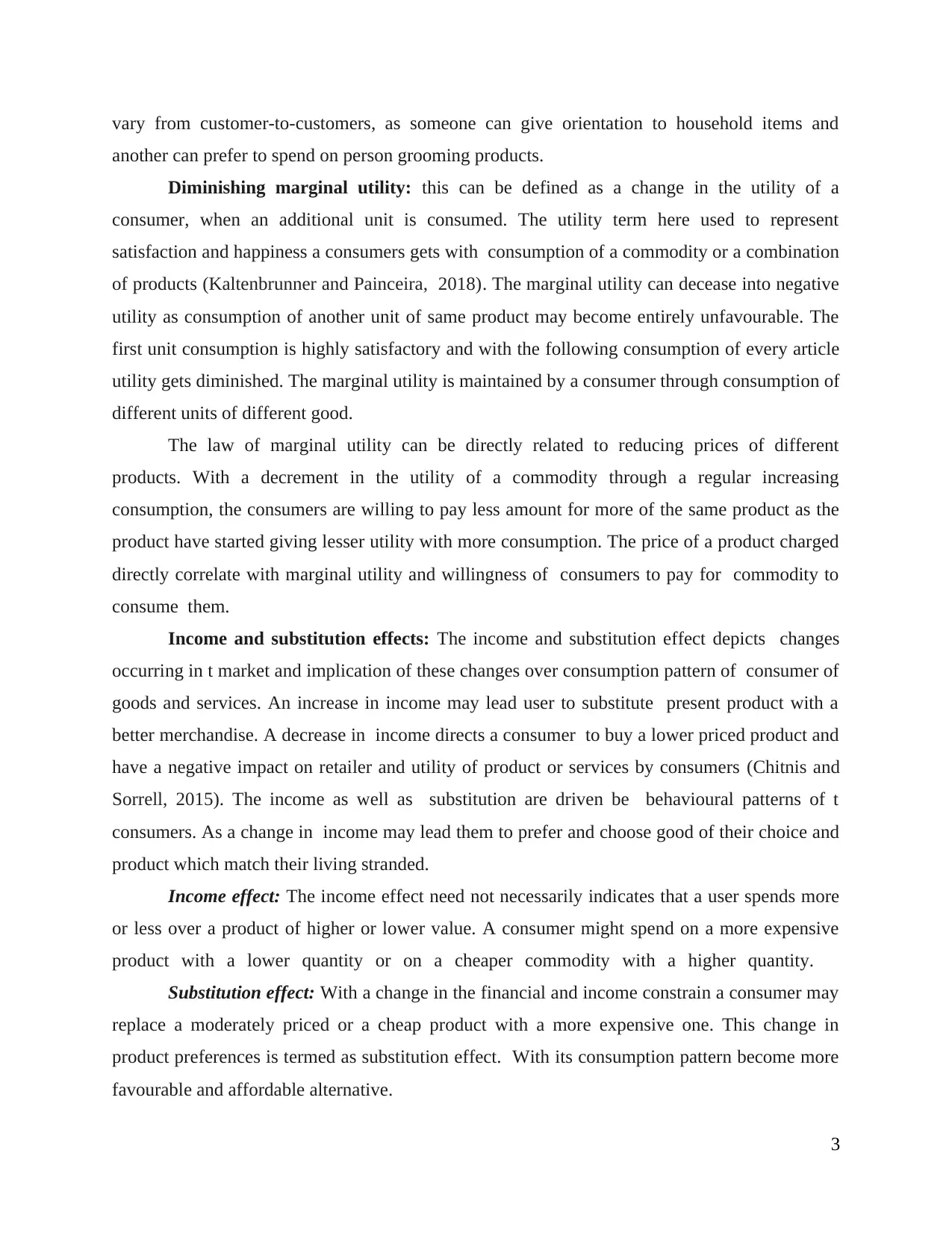
vary from customer-to-customers, as someone can give orientation to household items and
another can prefer to spend on person grooming products.
Diminishing marginal utility: this can be defined as a change in the utility of a
consumer, when an additional unit is consumed. The utility term here used to represent
satisfaction and happiness a consumers gets with consumption of a commodity or a combination
of products (Kaltenbrunner and Painceira, 2018). The marginal utility can decease into negative
utility as consumption of another unit of same product may become entirely unfavourable. The
first unit consumption is highly satisfactory and with the following consumption of every article
utility gets diminished. The marginal utility is maintained by a consumer through consumption of
different units of different good.
The law of marginal utility can be directly related to reducing prices of different
products. With a decrement in the utility of a commodity through a regular increasing
consumption, the consumers are willing to pay less amount for more of the same product as the
product have started giving lesser utility with more consumption. The price of a product charged
directly correlate with marginal utility and willingness of consumers to pay for commodity to
consume them.
Income and substitution effects: The income and substitution effect depicts changes
occurring in t market and implication of these changes over consumption pattern of consumer of
goods and services. An increase in income may lead user to substitute present product with a
better merchandise. A decrease in income directs a consumer to buy a lower priced product and
have a negative impact on retailer and utility of product or services by consumers (Chitnis and
Sorrell, 2015). The income as well as substitution are driven be behavioural patterns of t
consumers. As a change in income may lead them to prefer and choose good of their choice and
product which match their living stranded.
Income effect: The income effect need not necessarily indicates that a user spends more
or less over a product of higher or lower value. A consumer might spend on a more expensive
product with a lower quantity or on a cheaper commodity with a higher quantity.
Substitution effect: With a change in the financial and income constrain a consumer may
replace a moderately priced or a cheap product with a more expensive one. This change in
product preferences is termed as substitution effect. With its consumption pattern become more
favourable and affordable alternative.
3
another can prefer to spend on person grooming products.
Diminishing marginal utility: this can be defined as a change in the utility of a
consumer, when an additional unit is consumed. The utility term here used to represent
satisfaction and happiness a consumers gets with consumption of a commodity or a combination
of products (Kaltenbrunner and Painceira, 2018). The marginal utility can decease into negative
utility as consumption of another unit of same product may become entirely unfavourable. The
first unit consumption is highly satisfactory and with the following consumption of every article
utility gets diminished. The marginal utility is maintained by a consumer through consumption of
different units of different good.
The law of marginal utility can be directly related to reducing prices of different
products. With a decrement in the utility of a commodity through a regular increasing
consumption, the consumers are willing to pay less amount for more of the same product as the
product have started giving lesser utility with more consumption. The price of a product charged
directly correlate with marginal utility and willingness of consumers to pay for commodity to
consume them.
Income and substitution effects: The income and substitution effect depicts changes
occurring in t market and implication of these changes over consumption pattern of consumer of
goods and services. An increase in income may lead user to substitute present product with a
better merchandise. A decrease in income directs a consumer to buy a lower priced product and
have a negative impact on retailer and utility of product or services by consumers (Chitnis and
Sorrell, 2015). The income as well as substitution are driven be behavioural patterns of t
consumers. As a change in income may lead them to prefer and choose good of their choice and
product which match their living stranded.
Income effect: The income effect need not necessarily indicates that a user spends more
or less over a product of higher or lower value. A consumer might spend on a more expensive
product with a lower quantity or on a cheaper commodity with a higher quantity.
Substitution effect: With a change in the financial and income constrain a consumer may
replace a moderately priced or a cheap product with a more expensive one. This change in
product preferences is termed as substitution effect. With its consumption pattern become more
favourable and affordable alternative.
3
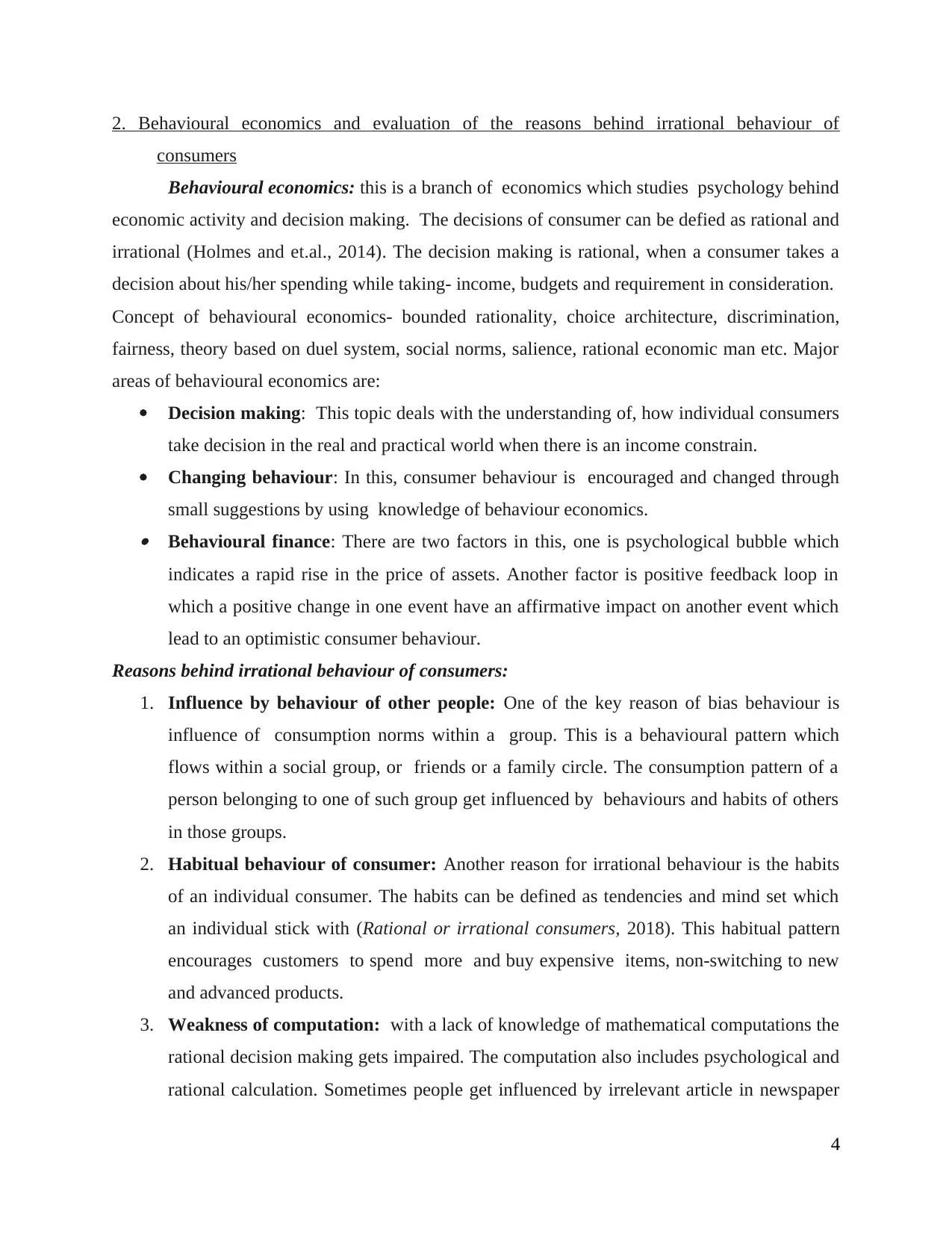
2. Behavioural economics and evaluation of the reasons behind irrational behaviour of
consumers
Behavioural economics: this is a branch of economics which studies psychology behind
economic activity and decision making. The decisions of consumer can be defied as rational and
irrational (Holmes and et.al., 2014). The decision making is rational, when a consumer takes a
decision about his/her spending while taking- income, budgets and requirement in consideration.
Concept of behavioural economics- bounded rationality, choice architecture, discrimination,
fairness, theory based on duel system, social norms, salience, rational economic man etc. Major
areas of behavioural economics are:
Decision making: This topic deals with the understanding of, how individual consumers
take decision in the real and practical world when there is an income constrain.
Changing behaviour: In this, consumer behaviour is encouraged and changed through
small suggestions by using knowledge of behaviour economics. Behavioural finance: There are two factors in this, one is psychological bubble which
indicates a rapid rise in the price of assets. Another factor is positive feedback loop in
which a positive change in one event have an affirmative impact on another event which
lead to an optimistic consumer behaviour.
Reasons behind irrational behaviour of consumers:
1. Influence by behaviour of other people: One of the key reason of bias behaviour is
influence of consumption norms within a group. This is a behavioural pattern which
flows within a social group, or friends or a family circle. The consumption pattern of a
person belonging to one of such group get influenced by behaviours and habits of others
in those groups.
2. Habitual behaviour of consumer: Another reason for irrational behaviour is the habits
of an individual consumer. The habits can be defined as tendencies and mind set which
an individual stick with (Rational or irrational consumers, 2018). This habitual pattern
encourages customers to spend more and buy expensive items, non-switching to new
and advanced products.
3. Weakness of computation: with a lack of knowledge of mathematical computations the
rational decision making gets impaired. The computation also includes psychological and
rational calculation. Sometimes people get influenced by irrelevant article in newspaper
4
consumers
Behavioural economics: this is a branch of economics which studies psychology behind
economic activity and decision making. The decisions of consumer can be defied as rational and
irrational (Holmes and et.al., 2014). The decision making is rational, when a consumer takes a
decision about his/her spending while taking- income, budgets and requirement in consideration.
Concept of behavioural economics- bounded rationality, choice architecture, discrimination,
fairness, theory based on duel system, social norms, salience, rational economic man etc. Major
areas of behavioural economics are:
Decision making: This topic deals with the understanding of, how individual consumers
take decision in the real and practical world when there is an income constrain.
Changing behaviour: In this, consumer behaviour is encouraged and changed through
small suggestions by using knowledge of behaviour economics. Behavioural finance: There are two factors in this, one is psychological bubble which
indicates a rapid rise in the price of assets. Another factor is positive feedback loop in
which a positive change in one event have an affirmative impact on another event which
lead to an optimistic consumer behaviour.
Reasons behind irrational behaviour of consumers:
1. Influence by behaviour of other people: One of the key reason of bias behaviour is
influence of consumption norms within a group. This is a behavioural pattern which
flows within a social group, or friends or a family circle. The consumption pattern of a
person belonging to one of such group get influenced by behaviours and habits of others
in those groups.
2. Habitual behaviour of consumer: Another reason for irrational behaviour is the habits
of an individual consumer. The habits can be defined as tendencies and mind set which
an individual stick with (Rational or irrational consumers, 2018). This habitual pattern
encourages customers to spend more and buy expensive items, non-switching to new
and advanced products.
3. Weakness of computation: with a lack of knowledge of mathematical computations the
rational decision making gets impaired. The computation also includes psychological and
rational calculation. Sometimes people get influenced by irrelevant article in newspaper
4
⊘ This is a preview!⊘
Do you want full access?
Subscribe today to unlock all pages.

Trusted by 1+ million students worldwide
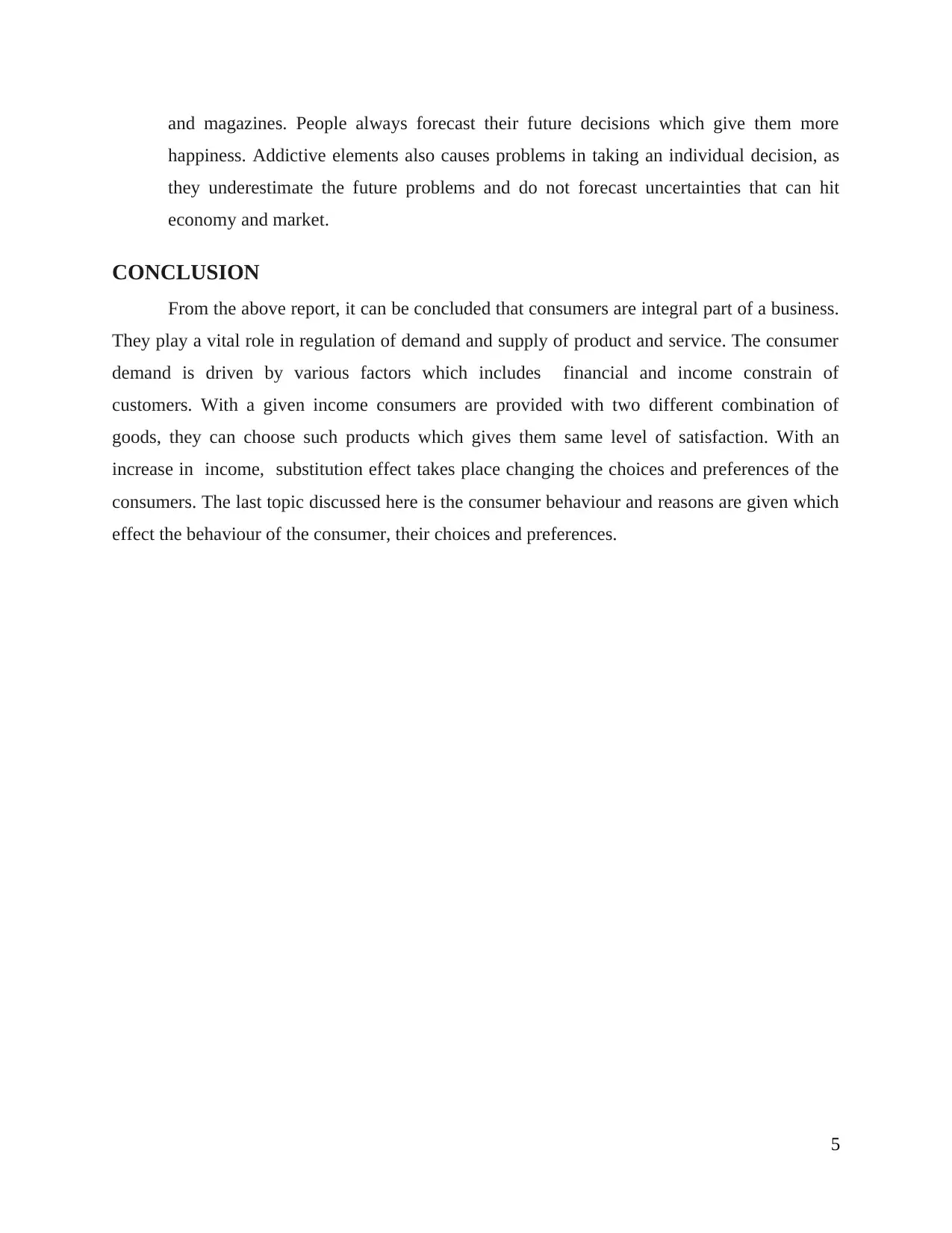
and magazines. People always forecast their future decisions which give them more
happiness. Addictive elements also causes problems in taking an individual decision, as
they underestimate the future problems and do not forecast uncertainties that can hit
economy and market.
CONCLUSION
From the above report, it can be concluded that consumers are integral part of a business.
They play a vital role in regulation of demand and supply of product and service. The consumer
demand is driven by various factors which includes financial and income constrain of
customers. With a given income consumers are provided with two different combination of
goods, they can choose such products which gives them same level of satisfaction. With an
increase in income, substitution effect takes place changing the choices and preferences of the
consumers. The last topic discussed here is the consumer behaviour and reasons are given which
effect the behaviour of the consumer, their choices and preferences.
5
happiness. Addictive elements also causes problems in taking an individual decision, as
they underestimate the future problems and do not forecast uncertainties that can hit
economy and market.
CONCLUSION
From the above report, it can be concluded that consumers are integral part of a business.
They play a vital role in regulation of demand and supply of product and service. The consumer
demand is driven by various factors which includes financial and income constrain of
customers. With a given income consumers are provided with two different combination of
goods, they can choose such products which gives them same level of satisfaction. With an
increase in income, substitution effect takes place changing the choices and preferences of the
consumers. The last topic discussed here is the consumer behaviour and reasons are given which
effect the behaviour of the consumer, their choices and preferences.
5
Paraphrase This Document
Need a fresh take? Get an instant paraphrase of this document with our AI Paraphraser
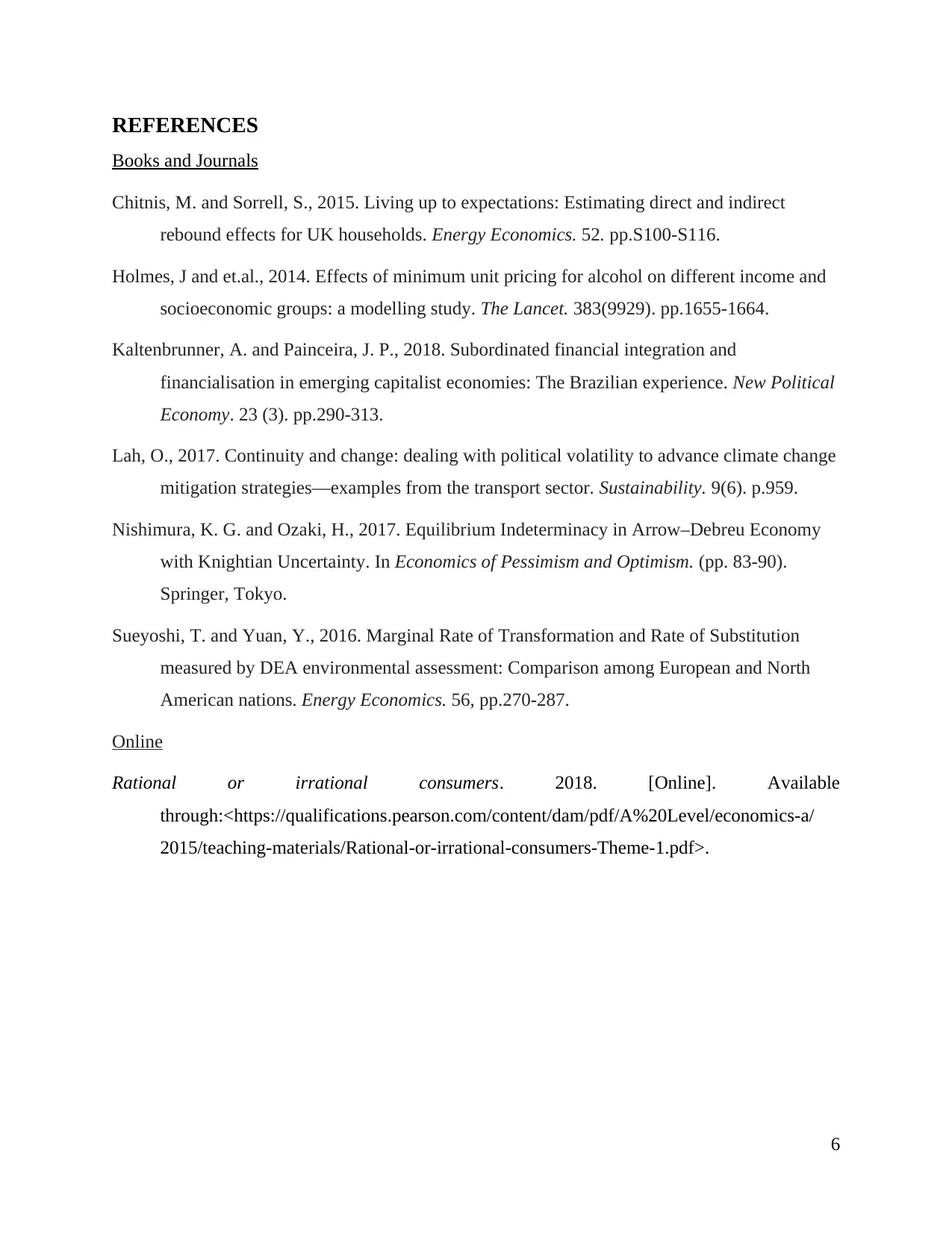
REFERENCES
Books and Journals
Chitnis, M. and Sorrell, S., 2015. Living up to expectations: Estimating direct and indirect
rebound effects for UK households. Energy Economics. 52. pp.S100-S116.
Holmes, J and et.al., 2014. Effects of minimum unit pricing for alcohol on different income and
socioeconomic groups: a modelling study. The Lancet. 383(9929). pp.1655-1664.
Kaltenbrunner, A. and Painceira, J. P., 2018. Subordinated financial integration and
financialisation in emerging capitalist economies: The Brazilian experience. New Political
Economy. 23 (3). pp.290-313.
Lah, O., 2017. Continuity and change: dealing with political volatility to advance climate change
mitigation strategies—examples from the transport sector. Sustainability. 9(6). p.959.
Nishimura, K. G. and Ozaki, H., 2017. Equilibrium Indeterminacy in Arrow–Debreu Economy
with Knightian Uncertainty. In Economics of Pessimism and Optimism. (pp. 83-90).
Springer, Tokyo.
Sueyoshi, T. and Yuan, Y., 2016. Marginal Rate of Transformation and Rate of Substitution
measured by DEA environmental assessment: Comparison among European and North
American nations. Energy Economics. 56, pp.270-287.
Online
Rational or irrational consumers. 2018. [Online]. Available
through:<https://qualifications.pearson.com/content/dam/pdf/A%20Level/economics-a/
2015/teaching-materials/Rational-or-irrational-consumers-Theme-1.pdf>.
6
Books and Journals
Chitnis, M. and Sorrell, S., 2015. Living up to expectations: Estimating direct and indirect
rebound effects for UK households. Energy Economics. 52. pp.S100-S116.
Holmes, J and et.al., 2014. Effects of minimum unit pricing for alcohol on different income and
socioeconomic groups: a modelling study. The Lancet. 383(9929). pp.1655-1664.
Kaltenbrunner, A. and Painceira, J. P., 2018. Subordinated financial integration and
financialisation in emerging capitalist economies: The Brazilian experience. New Political
Economy. 23 (3). pp.290-313.
Lah, O., 2017. Continuity and change: dealing with political volatility to advance climate change
mitigation strategies—examples from the transport sector. Sustainability. 9(6). p.959.
Nishimura, K. G. and Ozaki, H., 2017. Equilibrium Indeterminacy in Arrow–Debreu Economy
with Knightian Uncertainty. In Economics of Pessimism and Optimism. (pp. 83-90).
Springer, Tokyo.
Sueyoshi, T. and Yuan, Y., 2016. Marginal Rate of Transformation and Rate of Substitution
measured by DEA environmental assessment: Comparison among European and North
American nations. Energy Economics. 56, pp.270-287.
Online
Rational or irrational consumers. 2018. [Online]. Available
through:<https://qualifications.pearson.com/content/dam/pdf/A%20Level/economics-a/
2015/teaching-materials/Rational-or-irrational-consumers-Theme-1.pdf>.
6
1 out of 8
Related Documents
Your All-in-One AI-Powered Toolkit for Academic Success.
+13062052269
info@desklib.com
Available 24*7 on WhatsApp / Email
![[object Object]](/_next/static/media/star-bottom.7253800d.svg)
Unlock your academic potential
Copyright © 2020–2025 A2Z Services. All Rights Reserved. Developed and managed by ZUCOL.




